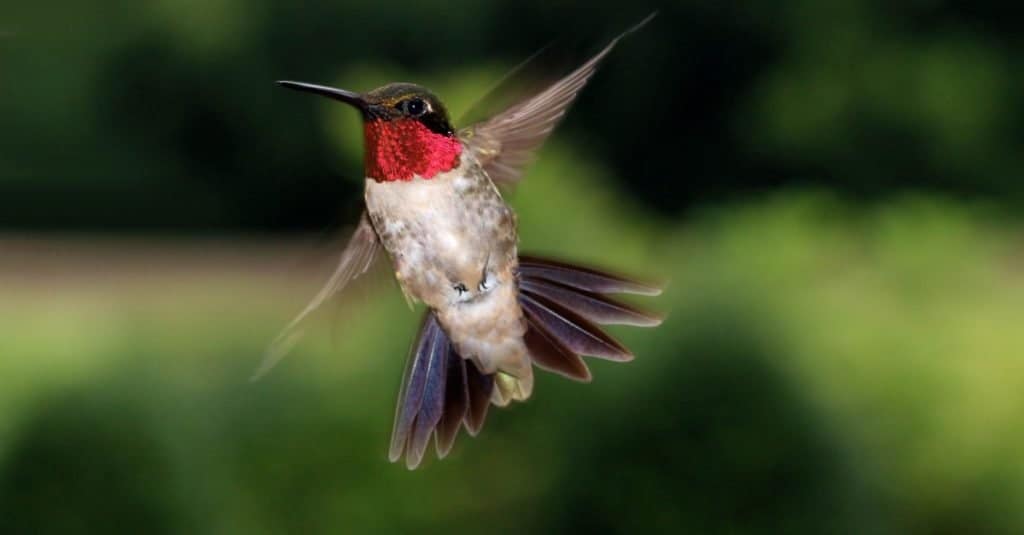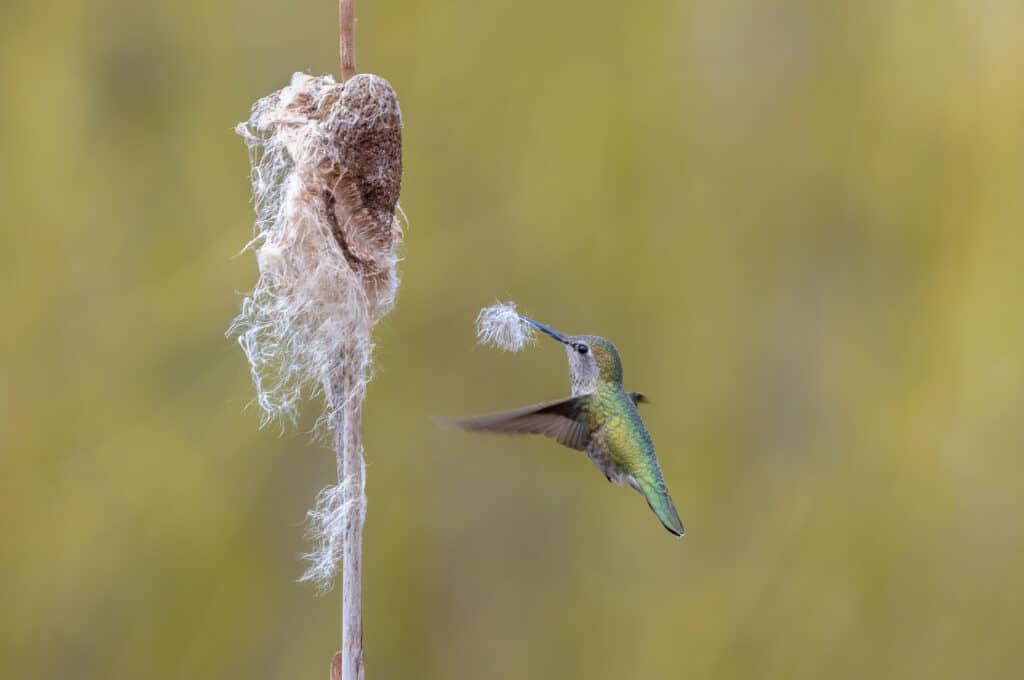You’ve probably heard about geese, whales, and buffalo migrating due to extreme weather changes or to find food for their young. But did you know that there is a tiny, five-inch traveler that also migrates? The hummingbird! These tiny, feathered hummers get their name because they do just that: their wings “hum” as they beat them up to a whopping 80 times per second. But they don’t just fly for a few miles… some travel hundreds of miles a day! Let’s take a closer look at the amazing feats of hummingbird migration!
Why do Hummingbirds Migrate?
When the weather begins to turn toward cooler temperatures in the fall, a few select hummingbird species begin long migrations from their northern breeding grounds in the United States to warmer wintering grounds in the south.
While their northern breeding grounds provide ample food during the summer months, the fall and winter are much colder so there are less insects, and flowers, and their sweet nectar disappears. Hummingbirds in these regions often migrate not only to go somewhere warmer, but to find food and flowers.
When Hummingbirds Migrate

Ruby-throated hummingbirds are one of around twenty species that migrate.
©Ramona Edwards/Shutterstock.com
Of the over 300 species of hummingbirds, only a few – less than 20 – migrate at all. Many of the well-known hummingbirds often migrate, like ruby-throated hummingbirds, Rufous hummingbirds, Allen’s hummingbirds, and black-chinned hummingbirds. What’s even more unusual is that those that do migrate travel individually, rather than in groups or flocks like other birds.
In the late summer or early fall – around July, August, or September – hummingbirds begin their long flight south from the United States to South and Central America. For their return to the U.S., they can begin to fly north as early as January, since it takes several months to make the trip. They arrive in the U.S. and Canada around May, where they breed and find that their tasty meals (nectar and bugs) are waiting in abundance once again.
How far do Hummingbirds Migrate?

Some hummingbirds migrate thousands of miles to warmer regions where there is plenty of food.
©Keneva Photography/Shutterstock.com
Some hummingbirds do not migrate too far for winter, while others may travel thousands of miles during a single migration! Although hummingbirds are only five inches long or less depending on the species, many can fly at over 25 miles per hour! However, even at that speed, fall migration still takes quite a while. Some hummingbirds will migrate for 50 days or more before they reach their final destination.
Rufous hummingbirds migrate over 3,000-4,000 miles, flying from northern Alaska all the way down to Mexico! This is quite the journey, since these small birds are only three inches long, and they fly over the towering Rocky Mountains during their migration. Calliope hummingbirds migrate from Canada and the northwestern United States all the way down to Central America, flying for over 2,000-2,500 miles each way.
Ruby-throated hummingbirds fly over 2,000 miles each season as they travel from Canada down to Panama. Rather than flying along the shoreline, these bold birds often migrate across the open water of the Gulf of Mexico, sometimes flying 500 miles without taking a break! Others often take temporary pit stops on boats and oil rigs to catch their breath. Older birds typically begin their migration earlier in the season. Their stopovers usually take less time than those of younger birds, and they arrive in better shape (maybe they have more frequent flyer miles).
How Hummingbirds Prepare to Migrate

Hummingbirds need to eat approximately half of their own body weight every day in preparation for their migration
©rck_953/Shutterstock.com
These incredible animals need a high level of fat in their diets to support them so that they can fly long distances when they’re ready. Hummingbirds eat every 10-15 minutes, consuming half their body weight daily as they build the fat reserves they need for the trip. They need to eat the nectar of many thousands of flowers and tiny insects each day to make that happen. A hummingbird almost doubles its body weight before they are ready to migrate.
Hummingbirds typically have a super-fast metabolism, which is why they enjoy diets filled with sugar-rich nectar. However, these birds and cold weather do not mix. In fact, there’s a phenomenon called “hypothermic torpor” which is a trance-like state hummingbirds enter when the temperatures start to go down or there’s not enough to eat. When their body temperature drops below 105 degrees Fahrenheit, they enter this coma-like state.
This condition conserves their energy, helping them to use just enough to stay warm. However, it usually only lasts overnight, so it can’t really be called “hibernation.” It’s simply a biological process that helps them to conserve energy and build up their fat stores as they prepare for migration.
When Can You See Hummingbirds?
In general, you are most likely to see hummingbirds in Canada and the United States from March through the beginning of September. Ruby-throated hummingbirds are much more common in the eastern half of the U.S., while black-chinned hummingbirds tend to favor the western half. Rufous hummingbirds can be seen in the Pacific Northwest. Costa’s hummingbirds seem to enjoy hot summers and desert areas in the southwest United States.
If you are in an area with hummingbirds, you can keep your hummingbird feeders full of fresh hummingbird nectar, even during winter months if you live in warmer areas. Don’t worry, this will not tempt migrating birds to stay too long, as their biological clocks signal when it’s time for the hummingbird migration. If you live in colder areas, you can maintain hummingbird feeders from early spring through late fall to help provide these tiny migrators with food as they prepare for winter travels.
Just be sure to keep your hummingbird feeder clean and replace nectar on a regular basis so it doesn’t spoil and hurt the birds. You can also plant flowers that attract hummingbirds to give them a natural food source. Flowers will provide your home colorful blooms as well as fun hummingbird visitors to watch throughout the summer!
Which Types of Hummingbirds Migrate?
While there are 300 different species of hummingbird species in the world, only 20 or so participate in hummingbird migrations. Here are a few examples of hummingbirds that often migrate when it gets cold in the fall.
Ruby-Throated Hummingbird

The ruby-throated hummingbird sometimes flies non-stop for 500 miles across the Gulf of Mexico!
©CounselorB/Shutterstock.com
They’re the only hummer that lives in the eastern U.S. This species isn’t the most social bird and can be downright ornery, except when mating. Both male and female ruby-throated hummingbirds attack other species that might get too close to their feeding boundaries. Males can be recognized more easily since they have that gorgeous red “collar” around their throats.
Leaving North American in the fall, this beauty can fly 500 miles to cross the Gulf of Mexico in less than a day. They are known to double their fat mass in preparation to cross the massive body of water. Their wing beats are more than 50 times per second which helps to explain what powers these tiny-but-mighty birds display when they’re migrating from Canada and the U.S. to Mexico, Costa Rica, or Panama. Many also migrate to Florida.
Anna’s Hummingbird

Anna’s hummingbirds usually make short migrations from Arizona to California
©Devonyu /Shutterstock.com
Named after the 19th century Italian duchess Anna Massena, these iridescent beauties live in the western coastal regions of the U.S. and Canada. Sometimes they migrate, although in the past several years this is much less common as the climate continues to shift. Anna’s hummingbirds can tolerate colder temperatures than many other species. However, some of these especially vocal birds do migrate for shorter trips from Arizona to California in mid-spring and return in late summer.
Black-Chinned Hummingbird
These migratory birds spend their winters in Central America and along the Gulf Coast, southern California, southern Arizona, and southern Texas. They have a large range and are seen in much of the western U.S., reaching into Canada and British Columbia. Like most hummingbird species, the male’s coloring is much more vibrant. Males have a striking black head and neck with a thin strip of iridescent purple at the base.
Calliope Hummingbird

Despite their small size, Calliope hummingbirds migrate to Mexico every year
©iStock.com/McBenjamen
The smallest hummingbird in North America is the Calliope hummingbird. They seem to like the high elevations of the mountains in the northwest United States and Canada. Despite their tiny size, they migrate all the way down to Mexico each year. Calliope hummingbirds have throats that stand out with a streaked pattern, usually with some red coloring.
Rufous Hummingbird

Rufous hummingbirds deserve a gold medal when it comes to migrating. These tiny birds travel nearly 4,000 miles on their way to warmer regions!
©Devonyu/Shutterstock.com
Rufous hummingbirds make one of the longest migratory trips in the world of birds, flying nearly 4,000 miles from the western United States, Pacific Northwest, and Canada down to Mexico during the winter months. These Olympian-like hummingbirds are small (only 3 inches long) but fierce animals that can be quite feisty and very aggressive. They have striking orange, gold, or orange-red feathers, particularly around the neck.
Allen’s Hummingbird
These small birds tend to hang out along the western coast of the United States, particularly in southern Oregon and California. They look a lot like Rufous hummingbirds, but instead have iridescent red throats (males) or dull white (females). However, like Rufous hummingbirds, Allen’s hummingbirds are also quite territorial and aggressive. These tiny hummingbirds migrate down to Mexico in the fall, and return earlier than other hummingbird species, usually departing in December.
Costa’s Hummingbird

Costa’s hummingbirds love warm weather and migrate to Mexico for the winter.
©Rick Scuteri/Shutterstock.com
You are likely to see one of these warm-weather-loving birds in the southwest United States. Males have a rich violet-colored head and face that boldly contrasts with their green and brown bodies. Females are a bit less vibrant, with violet feathers and a white throat. Costa’s hummingbirds spend their summers in California and Arizona deserts and migrate a short distance down to northern Mexico during the winter.
Broad-Tailed Hummingbird
After breeding season, broad-tailed hummingbirds head out for warmer climates, migrating down to Mexico and Guatemala. They spend the spring and summer in Arizona, Colorado, Wyoming, and southern Montana. Broad-tailed hummingbirds prefer habitats with forests, mountains, and meadows, and are known for the loud, metallic trill sounds they make. Males have dazzling rose and magenta-colored throats that contrast beautifully with their iridescent green backs and white chests. Females look very similar in appearance, but they are less vibrant and do not have rose-colored throats.
Up Next:
- Discover the 10 Largest Hummingbirds in the World
- What Do Hummingbirds Eat?
- How and Where Do Hummingbirds Sleep?
- 10 Most Incredible Migratory Animals
The photo featured at the top of this post is © Keneva Photography/Shutterstock.com
Sources
- Journey North, Available here: https://journeynorth.org/hummingbirds/resources/article/article-pre-migration-hyperphagia
- Hummingbird Hobbyist, Available here: https://hummingbirdhobbyist.com/hummingbird-torpor/#Do_Hummingbirds_Go_Into_Torpor_Every_Night
- Hummingbirds Plus, Available here: https://www.hummingbirdsplus.org/hummingbird-migration-map-2021/
- Academic, Available here: https://academic.oup.com/auk/article/133/2/237/5149176
Thank you for reading! Have some feedback for us? Contact the AZ Animals editorial team.







